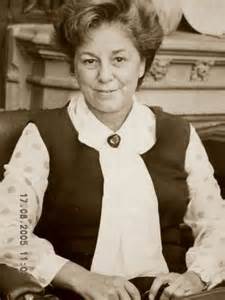The Milton Keynes links of a female pioneer
Over the last few years I’ve been researching Whips in the British Parliament and US Congress. There have been a number of interesting characters who have been Chief Whip – none more so than a Lady with links to Milton Keynes.
Baroness (Pat) Llewelyn-Davies was the first female Government Chief Whip in Parliament – serving in that post in the House of Lords from 1974 to 1979. It was one of the most challenging times to do the job; the Labour Party was in a minority in the House of Lords still dominated by the hereditary peers and none of the tools of ‘persuasion’ were available where members held their seats until they died. It was difficult enough for Government Whips in the House of Commons, but she turned out to be a star.
She was married to Richard Llewelyn-Davies. His obituary in the New York Times said this –
“The new-town project that attracted the most attention in his career, however, was his 1967 design for the city of Milton Keynes, north of London. Here, Lord Llewelyn-Davies attempted to move away from the English custom of designing new communities as utopian garden cities, serene and purely ordered; Milton Keynes resembles traditional, built-up, diverse cities as much as it does the garden city communities. In this sense it served as a kind of precursor to the attitudes toward urban planning that have become common in more recent years, as planners have become more interested in diversity as opposed to pure order.”
He had been made a member of the House of Lords in 1964 but his elevation as a political peer was seen as ironic by Richard Crossman , who wrote of her, “Patricia is a darling woman. One of the few people I feel really fond of in a deep sense. She remains beautiful, young and fresh. Alas, her life is a disaster now because her husband has been made the life peer although she is the real politician in the family.”
However, she joined Richard in the House of Lords in 1967 as a Peer in her own right.
Andrew Roth wrote in her obituary – “Her intelligence, charm and manipulative skills enabled her to soar ahead.” The Times obituary records that “it soon became clear that with her sex appeal and charm she had found her metier. Elderly Labour Peers – whether in Government or Opposition – positively relished being shepherded by her into the appropriate lobby.” Ted Graham recalls that “she laughed easily, and her face would often crease up into what I can only describe as a beautiful smile. She bustled rather than walked our corridors of power and stood no nonsense from those who came to the Lords from Cabinet and other high places. All were the same, no one was spared and she got the maximum out of her troops.” Andrew Roth wrote of “her central task of opposing 400 Tory peers (plus another 100 disguised as Crossbenchers) with 140 ageing Labour peers, of whom only 90 would turn up on a three-line whip.” Pottle wrote that “Llewelyn-Davies’s concern as government chief whip was with questions of function rather than form. She tried to deploy to best effect the relatively thin ranks of Labour peers nominally under her control. This required an intimate knowledge of the arcane workings of the house, and the intentions of the government, and considerable powers of persuasion.”
Recent Posts
Archives
Categories
- Abscam
- American Hustle
- Arriva
- Aylesbury
- Bancroft
- Bank Holidays
- Ben Westlake
- Birmingham
- Bletchley Park
- Bob Carr
- Bob Zeepvat
- Boudicca
- Bradwell
- Bribery
- British Council
- Bryan Dunleavy
- Buckingham Palace
- Buses
- Caldecotte
- Caldecotte Lake
- Calverleigh Crescent
- Campaigning
- Celts
- Central Milton Keynes
- Cinema
- Cineworld
- Citizenship
- Cold Callers
- Consumer Protection
- Corruption
- Cost of Living
- Craufurd Arms
- Crownhill
- Cycling
- Danelaw
- Danesborough
- Dennis Mynard
- Design of Milton Keynes
- Diabetes
- Dover
- Dulverton Drive
- Dunstable
- Elections
- Electoral Registration
- Emerson Valley
- Environment
- Environment Agency
- Exmoor
- First World War
- Flooding
- Football
- Fosse Way
- Fraudsters
- Furzton
- Furzton Lake
- Grange Farm
- Great Linford Waterside Festival
- Halloween
- Hartigans gravel pit
- Health
- History
- Howe Park
- Iron Age
- Iron Trunk Aqueduct
- J David Morgan
- Jennie Lee
- Kingsmead
- Libraries
- London
- Loughton Brook
- Loxbeare Drive
- Lynmouth Crescent
- Magiovinium
- Medbourne
- Medieval History
- Michael Farley
- Milton Keynes Archaeology Unit
- Milton Keynes Central Rail Station (MKC)
- Milton Keynes Council
- MK City Pathfinders
- MK Community Foundation
- MK Cycling Festival
- MK Dons
- Muddiford Lane
- Music
- Music in the Garden
- National Rail
- North Furzton
- Nye Bevan
- OFCOM
- Oldbrook
- Open Film Society
- Open University
- OU
- Oxley Park
- Parks Trust
- Pat Llewelyn-Davies
- Pennyland
- Politics
- Porlock Lane
- President Kennedy
- R A (Bob) Croft
- Railways
- Richard Llewelyn-Davies
- River Ouse
- River Ouzel
- Roman History
- Saving Money
- Shenley Brook End
- Shenley Church End
- Shenley Wood Village
- Snelshall Priory
- South Furzton
- Spam
- Spam emails
- St Albans
- Stony Live
- Stony Scala Film Club
- Stony Stratford
- Stony Stratford in Bloom
- Tattenhoe
- Thames Valley Police
- The Hub: Milton Keynes
- The Point
- Theft
- Thornborough
- Trading Standards
- Uncategorized
- Unwanted phone calls
- US Elections
- Virgin Trains
- Voting
- Walking
- Walsall
- Washington DC
- Waterstones
- Watling Street
- Wavendon Gate
- West Bletchley Carnival
- Westbury-by-Shenley
- Westminster
- Willen Lake
- Wolverton
- Wolverton Town Band
- Woodstock's Bakery
- Xscape
